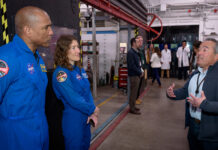NASA’s Green Rooftop Garden at Johnson Space Center: A Beacon of Sustainability
The Johnson Space Center in Houston, Texas, has long been a hub of innovation and exploration. However, beyond the towering rockets and cutting-edge laboratories, there lies a hidden gem that underscores NASA’s commitment to environmental stewardship—the rooftop garden atop Building 12. This verdant space, buzzing with bees, baby birds, and wildflowers, is a testament to NASA’s dedication to sustainability and ecological innovation.
A Historical Transformation
Originally built in 1963, Building 12 underwent a significant transformation in 2012. The renovation incorporated numerous energy-efficient features, ultimately earning the facility a LEED Gold certification. LEED, or Leadership in Energy and Environmental Design, is a globally recognized mark of sustainability achievement and leadership. Achieving Gold certification is a notable milestone, symbolizing that the building meets high standards of environmental responsibility.
An Unexpected Oasis
Positioned between the iconic Mission Control Center and Building 16, the rooftop garden is part of a broader initiative at Johnson Space Center to demonstrate that even unlikely locations can be transformed into thriving ecosystems. The project was spearheaded by Joel Walker, the director of Center Operations, in collaboration with NASA engineers. The rooftop garden embodies the principles of green architecture, featuring integrated solar panels, an underfloor air distribution system, and wind turbines.
“It was something of an experiment to see what worked well and what we might use in future projects,” said Walker.
Leading the Way in Sustainability
The Center Operations team at Johnson Space Center takes the lead on sustainability efforts, coordinating with various directorates and teams. Together, they manage the center’s 1,600 acres, which host a diverse array of plants and wildlife. The green roof on Building 12 provides numerous benefits, including reduced potable water and energy usage, improved stormwater management, protection from harmful UV rays, and increased stability in high winds. Remarkably, this eco-friendly roof has a projected lifespan of 50 years, which is double the 20 to 25 years typical of conventional roofs.
“I was genuinely surprised by the variety of native species thriving in our rooftop garden,” said Johnson’s wildlife biologist Strausser. “We’ve observed far more species than we ever anticipated, which is both fascinating and encouraging for our conservation efforts.”
Challenges and Triumphs
The journey to creating this vibrant rooftop garden was not without its challenges. Initially, the team planted non-native ornamental plants, which struggled to survive in Houston’s harsh climate. After several attempts, the team decided to hand-scatter a blend of native grass seed and wildflowers. This method proved to be highly successful and significantly more cost-effective than professional planting.
“Sometimes the easiest way is the best!” said Walker. “It looks great now and is much more durable too.”
Technical Innovations Explained
For readers unfamiliar with some of the technical aspects, here’s a brief explanation:
- Solar Panels: These devices convert sunlight into electricity, providing a renewable energy source for the building.
- Underfloor Air Distribution System: This system delivers air through the floor rather than traditional ceiling vents, enhancing energy efficiency and occupant comfort.
- Wind Turbines: These devices harness wind energy to generate electricity, further reducing the building’s reliance on non-renewable energy sources.
Broader Implications and Future Prospects
The success of the rooftop garden at Johnson Space Center has broader implications for sustainable architecture and urban planning. It demonstrates that even in urban or industrial environments, it is possible to create spaces that support biodiversity and contribute to environmental sustainability.
Moreover, the project serves as a model for future initiatives, both within NASA and beyond. By integrating green technologies and native plant species, other organizations can create similar spaces that offer ecological, economic, and social benefits.
Community and Expert Reactions
The rooftop garden has garnered positive reactions from both the community and experts in the field. Local environmental groups have praised NASA’s efforts, highlighting the project as a prime example of how large organizations can contribute to conservation efforts.
Environmental scientist Dr. Jane Allen commented, “NASA’s rooftop garden is a remarkable achievement. It shows that with the right planning and commitment, we can create sustainable and biodiverse spaces even in the most unexpected places.”
Conclusion: A Model for Sustainability
The rooftop garden atop Building 12 at Johnson Space Center is more than just a beautiful space—it is a symbol of NASA’s commitment to sustainability and innovation. By transforming an ordinary rooftop into a thriving ecosystem, NASA has set a precedent for future projects and demonstrated the potential for green architecture to make a significant impact.
As the world grapples with the challenges of climate change and environmental degradation, initiatives like this rooftop garden offer a glimmer of hope. They remind us that with creativity, collaboration, and commitment, we can create a more sustainable and resilient future.
For readers interested in sustainability, green architecture, or the innovative work being done at NASA, the rooftop garden at Johnson Space Center is a story worth following. It is a testament to what can be achieved when we think outside the box and embrace the principles of environmental stewardship.
Good to Know: LEED Certification
For those unfamiliar with LEED certification, it is a globally recognized certification system for green buildings. Buildings earn points for various sustainable practices and features, such as energy efficiency, water conservation, and the use of sustainable materials. LEED certification comes in four levels: Certified, Silver, Gold, and Platinum, with Gold being a high achievement indicating significant commitment to sustainability.
Final Thoughts
The rooftop garden at Johnson Space Center is a shining example of how innovative thinking and dedication to sustainability can transform even the most unexpected spaces. It is a beacon of hope and a model for future projects, proving that with the right approach, we can create environments that are both functional and ecologically beneficial.
For more Information, Refer to this article.


































